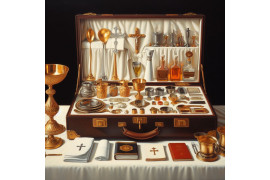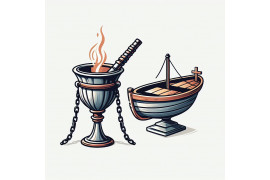In the world of candles, two essential tools often come into play: the candle snuffer, wick dipper, electric lighters, trimmers, and scissors. While both electric lighters and wicks serve the purpose of lighting candles, they differ in their methods and additional benefits.
A wick dipper is a common candle tool that allows you to dip the burning wick into the pool of wax, suffocating the flame. It is a slender metal tool with a curved end, perfect for extinguishing the wick. Wick dippers are essential for candle lovers who want to safely and easily put out their candles without blowing or smothering them. This method eliminates smoke and soot and coats the wick in wax for future burns. Candle care is important for maintaining a clean candle flame. Using electric lighters can help with this process. On the other hand, a candle snuffer, used to extinguish flames created by lighters or gas, features a bell-shaped cover that is placed over the flame, cutting off its oxygen supply and causing it to go out. This is particularly useful for candles with wicks that are difficult to extinguish.
However, wick dippers offer an added advantage by assisting in maintaining an even burn of the candle flame. They are a great accessory to have alongside lighters and candle toppers for proper candle care. By using common candle tools such as candle toppers and lighters, you can easily take care of your candles. By dipping and straightening the wick, these tools help ensure proper centering and prevent uneven burning.
Exploring Different Types of Candle Snuffers and Their Features
Traditional candle snuffers, lighters, with long handles, make it easy to reach the flame without getting too close. Use a wick trimmer to keep the flame even. These classic snuffers, designed for practicality, allow you to extinguish a candle with ease using lighters or a wick trimmer. However, modern candle snuffers and lighters have taken things up a notch with their innovative designs and additional features.
Long Handles or Ergonomic Designs
One of the main differences between traditional and modern candle snuffers lies in their handle design. Traditional snuffers typically feature long handles, which allow you to reach candles placed higher up or in hard-to-reach areas. This is especially useful for tall pillar candles or those placed on high shelves.
On the other hand, modern candle snuffers may come with ergonomic designs that prioritize comfort and ease of use. These snuffers are crafted with user-friendly handles that fit comfortably in your hand, making it effortless to extinguish candles without straining your wrist or fingers.
Attached Trays for Debris Collection
Another feature found in some candle snuffer models is an attached tray. These trays are common candle tools designed to catch any falling debris or hot wax when you extinguish the flame. They are especially useful when using a candle topper or trimming the candle wick. Candle tools, such as a candle topper, serve as a convenient solution to prevent messes and keep your surfaces clean by controlling the candle wick.
With a candle topper and attached tray, you don't have to worry about stray bits of burnt wick or dripping wax staining your tablecloth or furniture. These candle tools are designed to keep your surfaces clean and protected. The tray collects these remnants, making cleanup a breeze and ensuring that your candle experience remains hassle-free.
Specialty Snuffers for Unique Candles
While traditional and modern candle snuffers cater to standard-sized candles, there are also specialty snuffers available for larger candles or those with unique shapes. One example is the bell jar snuffer, which features a wide dome-shaped cover that can be placed over large container candles or even small lanterns.
The bell jar snuffer extinguishes the flame and helps contain any smoke emitted when snuffing out the candle. This makes it an ideal choice for scented candles, as it helps trap and preserve the fragrance within the enclosed space.
Candle snuffers come in various types and designs to suit different preferences and needs. Whether you opt for a traditional long-handled snuffer, a modern ergonomic design, or a specialty snuffer like the bell jar variety, these tools provide a safe and efficient way to extinguish candles without blowing out the flame or risking burns.
Consider your specific requirements, such as reach, comfort, and any additional features you may desire when choosing a candle snuffer. With the right snuffer by your side, you can enjoy your candlelit moments with ease and convenience.
Choosing the Right Wick Dipper for Your Candle Needs
A wick dipper is an essential tool for maintaining your candles and ensuring a clean burn. But with so many options available, how do you choose the right candle tools, like a wick dipper or a candle topper, for your specific needs? Here are some factors to consider before making your purchase of candle tools and a candle topper.
Material of the Wick Dipper
One of the first things to consider when selecting candle tools is the material of the wick dipper. The right candle topper can enhance your candle experience. Different materials offer varying levels of durability and aesthetics. Some common options for candle tools include stainless steel, brass, silver-plated, or gold-plated wick dippers. Additionally, a popular candle tool is the candle topper. Stainless steel is known for its strength and longevity, while brass adds a touch of elegance. Silver-plated or gold-plated wick dippers can provide a luxurious look that complements high-end candles.
Comfortable Handle Grip
Another important factor to consider is the handle grip of the wick dipper. Look for one that offers a comfortable grip that suits your preference. A well-designed handle will make it easier to maneuver and control the dipper when extinguishing the flame or dipping the wick into wax.
Size Matching Candle Diameter
Selecting a size that matches your candle's diameter is crucial for effective use of a wick dipper. The size should be proportionate to ensure efficient snuffing or dipping without any difficulty. Using an ill-fitting wick dipper may result in incomplete extinguishing or uneven wax distribution on the wick.
Benefits of Using a Wick Dipper
Using a wick dipper offers several benefits when compared to other methods such as blowing out candles or using scissors:
-
Minimizes Smoke: When you blow out a candle, it often produces smoke, which can leave behind an unpleasant odor. With a wick dipper, you can gently submerge the lit wick into hot wax, reducing smoke and minimizing any lingering smell.
-
Prevents Wick Drift: Over time, candle wicks tend to drift away from the center, resulting in an uneven burn. By using a wick dipper to push the wick back into the wax pool after extinguishing, you can help maintain a centered and even burn throughout the life of your candle.
-
Reduces Soot Buildup: Trimming the wick is essential for preventing excessive soot buildup. A wick dipper can serve as a multipurpose tool by allowing you to trim the wick before dipping it into the wax. This helps keep your candle burning cleanly and extends its lifespan.
Common Issues When Using a Wick Dipper and How to Prevent Them
Using a wick dipper can be a convenient way to extinguish your candles, but there are some common issues that you should be aware of. By understanding these issues and taking the necessary precautions, you can ensure that your candle experience is safe and enjoyable.
Excessive Dipping and Difficulty Relighting
One common issue when using a wick dipper is excessive dipping. While it may seem tempting to dip the wick multiple times to ensure it is fully submerged in wax, this can actually lead to too much wax on the wick. When there is an excess of wax, relighting the candle later on can become difficult.
To prevent this issue, it is important to exercise restraint when using a wick dipper. A single dip should be sufficient to extinguish the flame without overwhelming the wick with wax. By avoiding excessive dipping, you will make it easier to relight your candle in the future.
Handling Hot Wax Safely
Another issue that can arise when using a wick dipper is accidentally touching hot wax. After extinguishing the flame with the dipper, it's crucial to give the wax enough time to cool before handling it again. Failure to do so could result in burns or other injuries.
To prevent any mishaps, always exercise caution and patience when working with hot wax. Allow ample time for cooling before attempting to move or handle the candle. This simple precaution will help keep you safe while enjoying your candles.
Regular Cleaning for Optimal Performance
Over time, residue from burned wicks and melted wax can accumulate on your wick dipper. This buildup may affect its performance and make it less effective at extinguishing flames. To maintain optimal functionality, regular cleaning of your wick dipper is essential.
Cleaning your wick dipper is easy! Simply wipe off any residue after each use with a cloth or paper towel. For more stubborn buildup, you can use warm water and mild soap to gently clean the dipper. By keeping your wick dipper clean, you'll ensure that it continues to work effectively.
Benefits and Uses of Candle Snuffers in Proper Candle Care
Candle snuffers are essential tools for maintaining the longevity and appearance of your candles. They offer several benefits over blowing out candles directly, ensuring a safer and more enjoyable candle experience. Let's explore why candle snuffers are a must-have accessory for proper candle care.
Minimize Smoke and Soot Production
Blowing it out directly may lead to excessive smoke and soot production. This can create an unpleasant atmosphere and leave behind unsightly residue on your walls or ceilings. However, using a candle snuffer allows you to gently extinguish the flame without causing unnecessary smoke or soot.
Safer Alternative with Reduced Risks
Blowing out a candle can sometimes result in sparks or hot wax splatters, posing potential risks. However, by utilizing a candle snuffer, you can significantly reduce these hazards. The long handle of the snuffer keeps your hand at a safe distance from the flame, while ensuring that any sparks or wax splatters remain contained within the snuffer itself.
Protection Against Accidental Damage
Accidentally knocking into a lit candle can cause damage to its shape, wick, or even result in spilled hot wax. Fortunately, using a candle snuffer helps prevent such mishaps by allowing you to extinguish the flame without any physical contact with the wick or surrounding wax. This ensures that your candles maintain their original shape and appearance for longer periods.
Easy-to-Use Tool
Using a candle snuffer is incredibly simple and user-friendly. All you need to do is position the bell-shaped end of the snuffer over the flame until it is fully covered. The lack of oxygen will naturally extinguish the fire without creating any mess or fuss.
Versatile Design Options
Candle snuffers come in various designs and materials, allowing you to choose one that suits your personal style and preferences. Whether you prefer a classic silver snuffer or a more modern and decorative option, there is a wide range of choices available to complement your candle collection.
Enhanced Candle Rituals
For those who enjoy the ritualistic aspect of candle burning, using a snuffer can add an extra touch of elegance and mindfulness to the experience. The deliberate act of extinguishing the flame with a snuffer can create a sense of tranquility and intention, enhancing your overall enjoyment and appreciation for candles.
Understanding the Role of Candle Toppers and How They Differ from Snuffers and Dippers
Candle toppers are decorative covers placed on top of burning candles to enhance their aesthetic appeal. Unlike snuffers and dippers, candle toppers do not extinguish flames or interact with the wick directly. Instead, they primarily serve as decorative accessories while allowing a controlled burn by regulating airflow.
Candle Toppers: Enhancing Aesthetic Appeal
Candle toppers are designed to add a touch of elegance and style to your candles. They come in various shapes, sizes, and designs, allowing you to personalize your candle display. Whether you prefer intricate patterns, floral motifs, or simple geometric shapes, there's a candle topper out there for everyone.
-
Pros:
-
Enhances the visual appeal of candles
-
Adds a decorative element to any space
-
Allows customization and personalization
-
Cons:
-
Does not have a functional role in extinguishing flames or interacting with the wick
Snuffers: Safely Extinguishing Flames
Snuffers play an essential role in safely extinguishing candle flames without creating smoke or splattering wax. With their long handles and bell-shaped ends, snuffers allow you to gently place the snuffer cap over the flame, cutting off its oxygen supply and causing it to go out smoothly.
-
Pros:
-
Safely extinguishes flames without creating smoke
-
Prevents splattering wax when blowing out candles
-
Helps maintain a clean and tidy environment
-
Cons:
-
Primarily used for practical purposes rather than decoration
-
Limited design options compared to candle toppers
Dippers: Controlling Wick Length
Wick dippers are unique tools used for controlling the length of candle wicks before lighting them. By dipping the wick into melted wax using a dipper's hooked end, you can trim it to the desired length. This process helps prevent excessive burning, uneven flames, and soot buildup.
Mastering the Art of Caring for Your Candles with Snuffers and Dippers
We also discussed common issues when using a wick dipper and how to prevent them, along with the benefits and uses of candle snuffers in proper candle care. Lastly, we delved into understanding the role of candle toppers and how they differ from snuffers and dippers.
Now that you're armed with knowledge about these essential candle accessories, you can elevate your candle care routine to new heights. By using a high-quality snuffer or dipper specifically designed for candles, you can enhance their longevity and ensure a clean burn every time. Remember to handle your candles with care and always follow the manufacturer's instructions for optimal results.
FAQs
How do I use a candle snuffer?
To use a candle snuffer, simply place the bell-shaped end over the flame of a lit candle until it is extinguished. The design of the snuffer helps prevent wax splatter or smoke that may occur when blowing out a candle directly.
Can I use a wick dipper instead of blowing out my candles?
Yes! A wick dipper is an excellent alternative to blowing out your candles. To use it, gently push the burning wick into the melted wax pool using the curved end of the dipper until it is submerged. This method helps extinguish the flame without creating smoke or disturbing the surrounding area.
Are there any safety precautions I should take when using these accessories?
Absolutely! Always ensure that your candles are placed on heat-resistant surfaces away from flammable materials before using snuffers or dippers. Make sure to trim your wicks regularly to avoid excessive smoke or flickering flames.
Can I use a candle snuffer or wick dipper on any type of candle?
Candle snuffers and dippers are suitable for most types of candles, including jar candles, pillar candles, and tapered candles. However, always check the manufacturer's recommendations to ensure compatibility with your specific candle.
Are there any additional benefits to using these accessories?
Certainly! In addition to extinguishing your candles safely and reducing smoke, both snuffers and dippers can help minimize soot buildup on the walls of containers or holders. This allows for a cleaner and more aesthetically pleasing appearance while prolonging the life of your candles.



